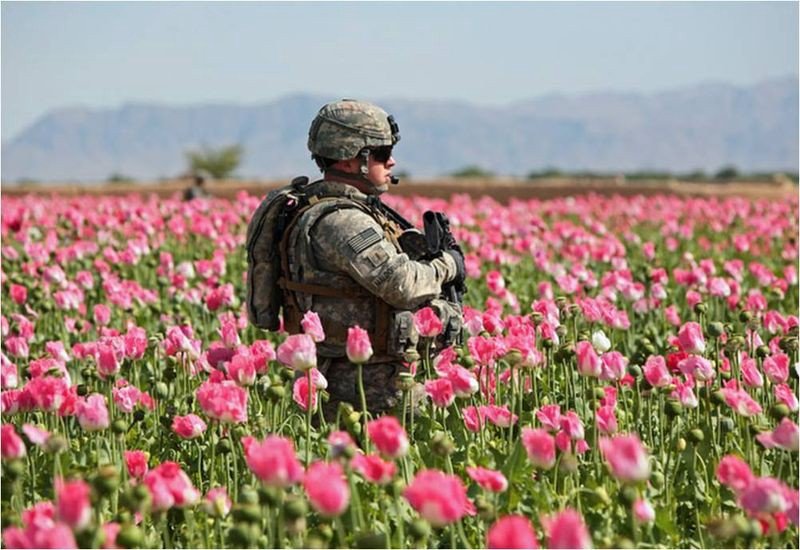U.S. anti-narcotics campaign in Afghanistan a big disaster

TEHRAN - The protracted war in Afghanistan has many convoluted dimensions and needless to say the foreign invaders have failed in almost every way. Their engagement in the war-ravaged country has only wreaked havoc, brought misery to the people and emboldened insurgent groups to carry out deadly strikes across the country.
More than 17 years after invading the country, the U.S.-led international coalition has reluctantly conceded defeat to insurgent groups, after miserably failing in counter-terrorism efforts. Today, security situation remains volatile, government is in tatters, terrorists strike at will, and people continue to live in fear. It pretty much sums up the horrible legacy of America in Afghanistan.
The much-hyped rebuilding and reconstruction projects of the U.S.-led coalition have also turned into a farce. It has only contributed to destruction and devastation post-2001.
One area where the international partners of the Afghan government have particularly been disastrous is counter-narcotics campaign. Notwithstanding the ‘strenuous efforts’ to dissuade Afghan farmers from opium plantation, the country continues to be the world’s top opium producer. Interestingly the area covered by opium fields in Afghanistan equals the total area of Mauritius.
The opium cultivation in Afghanistan hit a record high last year, according to a U.S. government watchdog body SIGAR, which described the counter-narcotics campaign of the U.S.-led coalition as a “failure”. Pertinently, the U.S. government has splurged about $8.7 billion on its counter-narcotics campaign in the war-torn country since 2001.
A new report by SIGAR made many interesting revelations, pointing to the farcical counter-narcotics campaign of the international community in Afghanistan. Despite billions of dollars, opium cultivation reached about 328,000 hectares (1,265 square miles) in 2017, marking an increase of 63 percent from the year before, and the highest amount recorded since 2002.
“To put it bluntly, these numbers spell failure, and the outlook is not encouraging,” John Sopko, the special inspector general, remarked in the report. “There’s more opium being grown now than when we started, there’s more heroin being produced than when we started, there’s more heroin being exported, there are more profits from the heroin going to the Taliban and to the other terrorist groups than when we started,” he later said in a TV show.
What Sopko said quite unapologetically and unequivocally is what many war-mongering hawks in Washington admit in private but refuse to admit in public, because it leaves them embarrassed. They don’t want the American taxpayers to know how their money is being wasted in a ludicrous campaign that is producing no results or how their money is being used to fuel insurgency or bomb Afghans.
The question hovering on everyone’s mind is: Who benefits most from the opium cultivation and why have the counter-narcotics efforts of international community failed? It is important to note that opium is a major source of revenue for the Taliban movement. The money from the sales of opium helps fuel insurgency across the country.
But the Taliban is not the only group benefiting from opium business in Afghanistan. Many criminal gangs, warlords, policemen, tribal elites, government officials also profit from it. And most of them enjoy patronage of the U.S. forces in Afghanistan. So, it is also a case of the conflict of interest.
The opium reduction program was one of two initiatives of the U.S. government apparently designed to resurrect the country’s agrarian economy. But the way it has been executed has raised more questions than answers. It has not only led to increase in opium cultivation but has fueled insurgency.
The U.S. forces have been carrying out airstrikes across the country to eliminate what they call ‘Taliban drug labs’. In February this year, the top U.S. commander in Afghanistan John Nicholson announced that his forces were bombing these labs to weaken the economy of the insurgent group. “We are hitting the Taliban where it hurts, which is their finances,” he said.
But he didn’t explain how the American forces intended to carry out these strikes, which according to many experts put lives of farmers in danger. As Thomas Ruttig, co-director of the Afghanistan Analysts Network (AAN) told in an interview recently, these labs are not what people in the West consider labs, and they are not manned by the Taliban fighters, meaning the casualties would more often be civilians.
That is how imaginative America’s counter-narcotics campaign in Afghanistan has been. No wonder why it has proved a big disaster.
The best possible, and the only, solution to the illicit opium economy in Afghanistan is the withdrawal of U.S.-led coalition forces, which is one of the main demands of insurgents to end the long-standing war. Unless the war doesn’t end, the opium production and smuggling is unlikely to go down.
If the U.S. forces could not eradicate poppy fields or what they call ‘Taliban drug labs’ in 17 years, chances are they won’t be able to do it now. Since they have admitted defeat in their longest war and failed in counter-narcotics campaign and other such farcical campaigns, it is time for the U.S.-led coalition forces to call it quits, end the drama and go home.
Leave a Comment